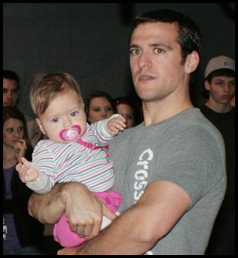Lately it’s difficult to go a week without hearing about the dangers of working out at a box.
“My friend tore her rotator cuff.” “My cousin did his ACL.” “I threw out my back.” My insurance company even offers a separate rhabdo waiver. Ugh.
I do my best to keep out of these conversations, be it in person, on the message board, or through other social media outlets. I don’t want to engage with an uneducated populace. Be it traditional gym owners who have lost revenue as members abandon for affiliates, or the media wanting to create a salacious story to earn thousands of comments on and hits to their websites, people are out to take down this strength and conditioning program. Enough already!
Here’s the thing: people suffer from injuries every day. Before this program, people were injured during sports and exercise. Injured a lot. Do you really think that running a 5K, 10K, 26.2 miles, Ultras, Triathlons, Iron Man races, etc. is less dangerous, or can cause less injuries than a few reps with poor form on a squat, or deadlift? I don’t.
Yes, there are some gyms that will allow constant poor movement. Don’t be that gym. If you want to be a good coach, if you want to grow your affiliate, you need potential and current members to understand that this program is safe, and show them so. You do this by teaching proper form and technique. You do this by helping them scale their workouts. It’s beneficial for them, and it’s what your clients pay you for.
It’s simple: if a member can’t perform an air squat, don’t let her progress to the overhead squat.
As an affiliate owner for over four years, I understand that some clients can only learn the hard way. There are people who will have a greater respect for the art of coaching if we let them fail on their own accord. Sometimes that’s good for their egos. But it’s certainly not the approach for everyone.
Perhaps this fitness program gets a bad rap because of the dumb stuff that some coaches program. Ring push-ups with the straps wrapped around a team member’s neck? Dual deadlifts? Human thrusters? Don’t fall into that trap! If you have a member that can’t deadlift properly, please don’t add banded deadlifts to their programming. If they can’t get into a full squat, don’t add chains! Remember: “Regress to progress.” “More is not better: better is better.”
In our chiropractic office, rest is a rare prescription. “Motion is lotion” (for the joints) is what we tell our box patients. The kettlebell and/or barbell are used to rehab many shoulder and lower back injuries. We teach squat mechanics for many knee injuries. If patients are not improving, then we pull back, we scale. Interestingly, our patients who do Affiliate programs tend on average to recuperate much faster than other patients. I attribute this to the full range of motion that box members achieve through exercise, with the emphasis on posterior chain and core.
Knee pain, hip pain, shoulder pain, back pain, all can improve with proper therapy. The pain can also dissipate through hard work with this program. It’s a shame that those stories can’t make the news too.
 Brian Strump – CrossFit Steele Creek
Brian Strump – CrossFit Steele Creek
Brian graduated from Logan Chiropractic College in 2003, and always had an interest in biomechanics and working with an athletic population. Eight years ago, he moved to Charlotte, NC and opened an office in a globo gym; all the while doing CrossFit at a local affiliate. After 4 years of practice in the globo gym, he decided to move closer to his home in Charlotte, and create a facility that would have his doctors office, and a CrossFit affiliate under one roof. In 2010, he opened CrossFit Steele Creek, and Premier Health and Rehab Solutions. The goal in opening an affiliate was to give patients a way to get stronger and move better under the supervision of coaches, as well is offering another avenue to patients to help with their overall health and fitness. This combination has lead to many other opportunities including writing articles in Muscle & Fitness and The Box Magazine, as well as being asked to be the team chiropractor for the Olympic Lifting team, Muscle Driver USA.